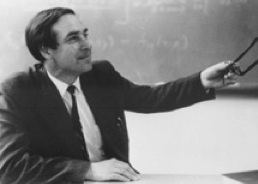James Case
Biography
Dr. James (Jim) Case was a professor of Mathematics at the University of Utah during the advent of computer graphics Adobe Systems, Atari and Evans and Sutherland. He was a pioneer in the field of parallel computing, as well as instrumental in calculating the firing tables for the Mercury Redstone rocket's successful first flight to space. He also worked extensively on Artificial Intelligence research.
Education
Ph.D. Tulane University 1955
Dissertation: Some Relations Between Induced Homomorphisms on Homology and Cohomology Groups Advisor: Unknown
Theses and Dissertations written under the advisory of James H. Case
Robert Renaldo Marshall
Computation of ÒeÓ
M.S., 1967
Advisor: James H. Case
Vadim Komkov
Applications of Homogeneous Contact Transformations
Ph.D., 1965
Advisor: James H. Case
Elbridge Wesley Sanders
A Modification of Moore-Smith Convergence Theory
M.S., 1964
Advisor: James H. Case
Wallace Leroy Hamilton
Categories of Automata Systems
Ph.D., 1967
Advisor: James H. Case
University of Utah Mathematics Department Theses and Disserations: 1960-1969
Projects
Jim had many projects ranging from geometrical kite-building and rockets to AI and computing. Many are not covered here, but will be in the future.
Multi-core Optimization, Rapid Supercomputer Implementation and Remembering a Pioneer
By James Bagley
"One of my favorite professors at the University of Utah was Dr. James Case, who pioneered in the science of parallel computing, and envisioned machines like the Coates Cluster. He even developed programming techniques to take advantage of such systems. That was over 40 years ago in the late 1960s. Dr. Case died unexpectedly at a relatively young age in 1990, just when advances in neural network hardware development were beginning to take advantage of his well-developed processes and research into artificial intelligence.
We were able to track down the granddaughter of Dr. Case, Amber I. Case, who is specializing in the field of cyborg anthropology. The field specifically analyzes interaction between humans and machines. Amber is the daughter of Elliot Case, an accomplished scientist and inventor in the field of acoustics, with upwards of 50 patents.
"I grew up thinking that everyone had a laboratory in their basement," says Amber, bemused. Already an expert mathematician and electronics technologist by high school, Amber studied Sociology and Anthropology at Lewis and Clark College. "I could make machines do anything, but had trouble communicating with people, so I wanted to work in the social sciences for my undergraduate degree."
She remembers Dr. Case as an incredibly fun person, who would build exotic and beautifully engineered kites and loved to spend weekends with his family. She also was, as a prodigy, amazed by his works dating to the 1960s.
"I remember reading his papers on three-dimensional processing when I was in high school, and thinking that he was at least 50 years ahead of his time."
We are confident that Amber, who wants to continue her post-graduate work at MIT, will carry on the family's tradition of technology advancement" [1].
Case Mathematics Library
After his death, Jim's mathematics and technical books were donated to the University of Utah where he taught. The library was named the Case library and is open to the mathematically-inclined public.
Books
Lectures of James H. Case on parallel programming of the Case- Stewart computers, 1967-1968 [Unknown Binding]
Societies
Attended the 1968 Fall Meeting of The Society for Industrial and Applied Mathematics (SIAM) in Philadelphia, Pennsylvania on October 21, 22 and 23, 1968.
SIAM Review © 1969 Society for Industrial and Applied Mathematics
Publications
Toward a Theory of Many Player Differential Games
SIAM Journal on Control Volume 7, Number 2, May, 1969 by James H. Case 179--197
Long-term memory modules by James H. Case and Paul S. Fisher
Department of Mathematics, University of Utah Salt Lake City, UT 84112, U.S.A.
Department of Computer Science, Kansas State University, Manhattan, KS 66506, U.S.A.
Received 27 September 1983; revised 26 October 1983. Available online 21 July 2005.
Abstract "One particular kind of structure offers possible explanations for long-term memory, efficient consolidation of stored information from the environment, clustering of data strings and multimodal functioning. It is a possible model for pieces of neural structure and its use offers a uniform method for both studying and constructing an extensive class of mechanisms".
Bulletin of Mathematical Biology: Volume 46, Issue 2, 1984, Pages 295-326
Long-term memory modules by James H. Case and Paul S. Fisher
Another 1-dimensional homogeneous continuum which contains an arc
Pacific Journal of Mathematics Volume XI, 1966. Pg. 455.
Further Reading
- Computer History
- Cellular Automata
- Artificial Intelligence
- University of Utah
- ARPA
- Early Rocketry
- Computer Graphics
